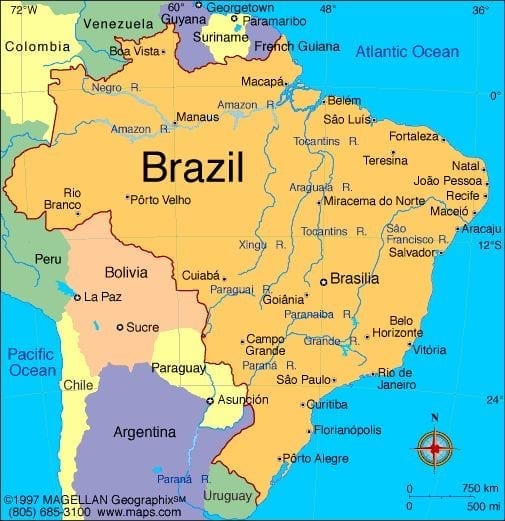
Book accommodation in any part of Brazil at great prices
Satellite Map of Brazil
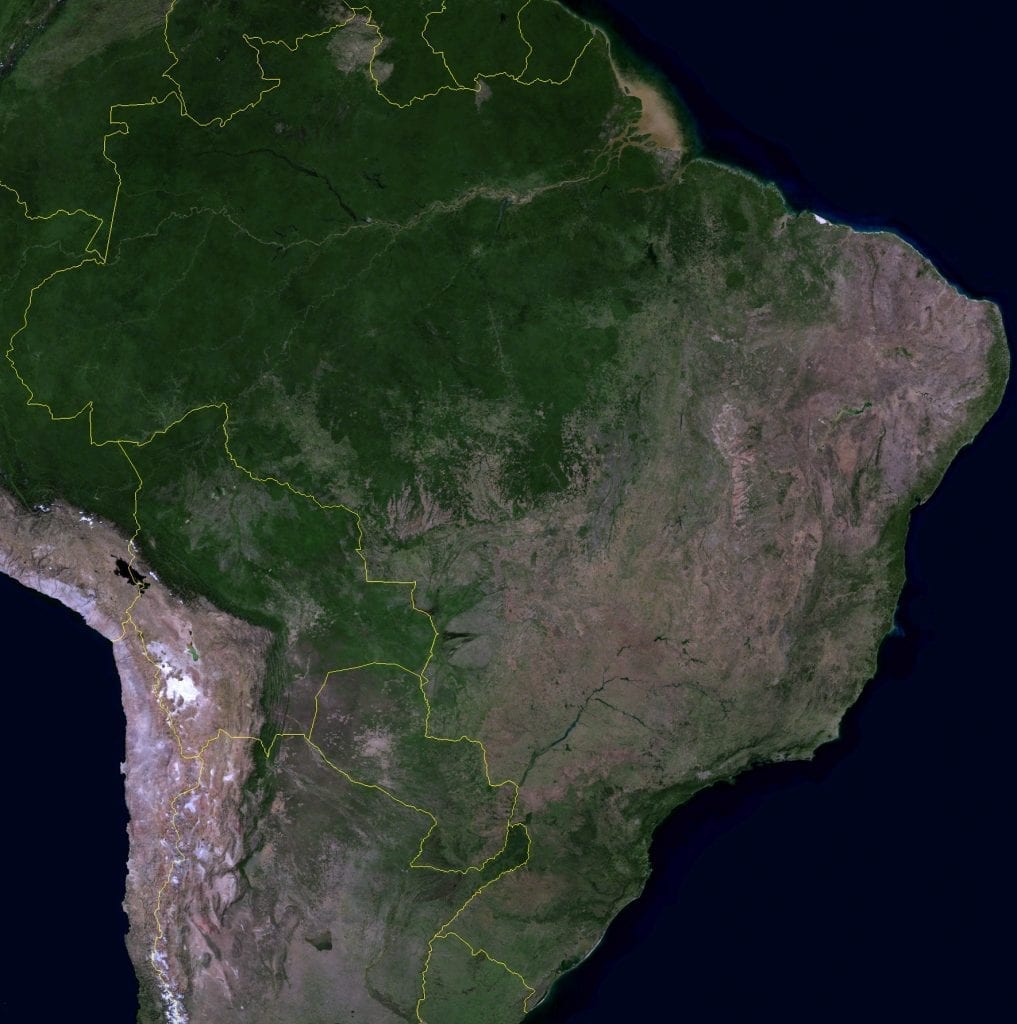
Vector Info graphic Map of Brazil
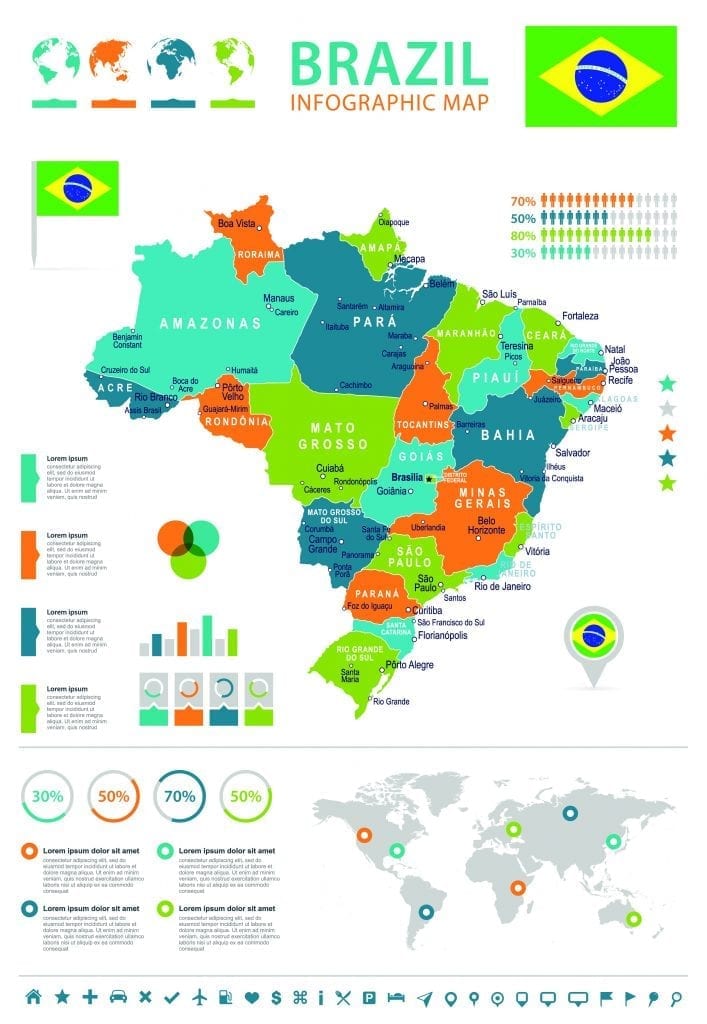
Administrative Map of Brazil
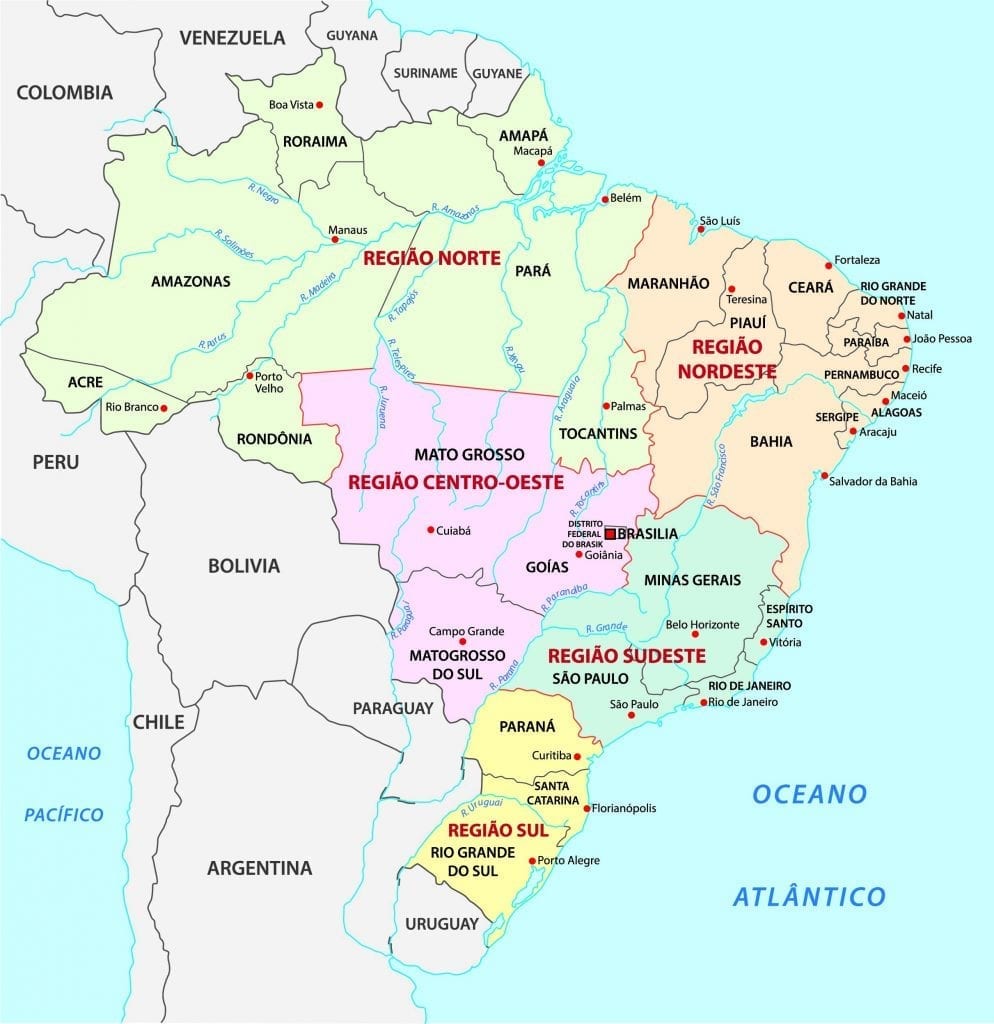
Tourist map of Brazil with landmarks and animals
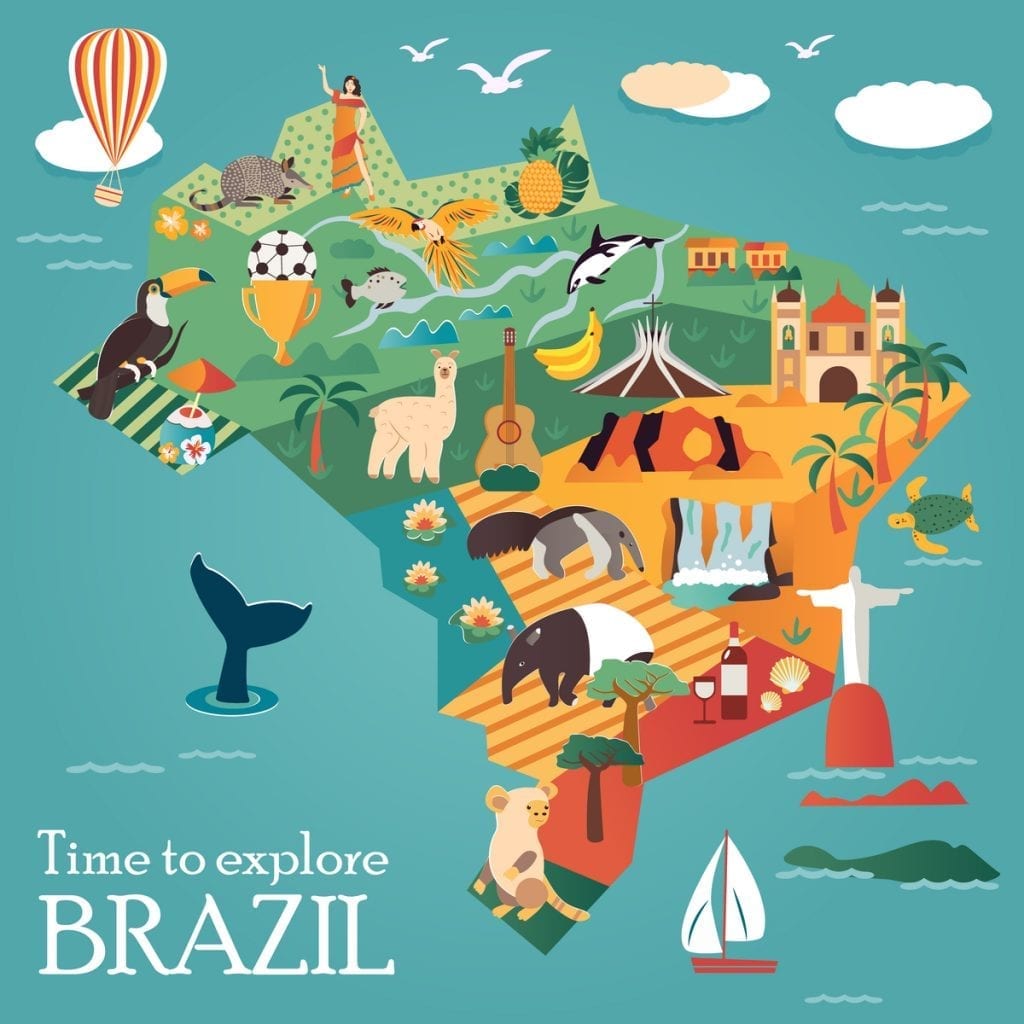
Map of Brazil Regions
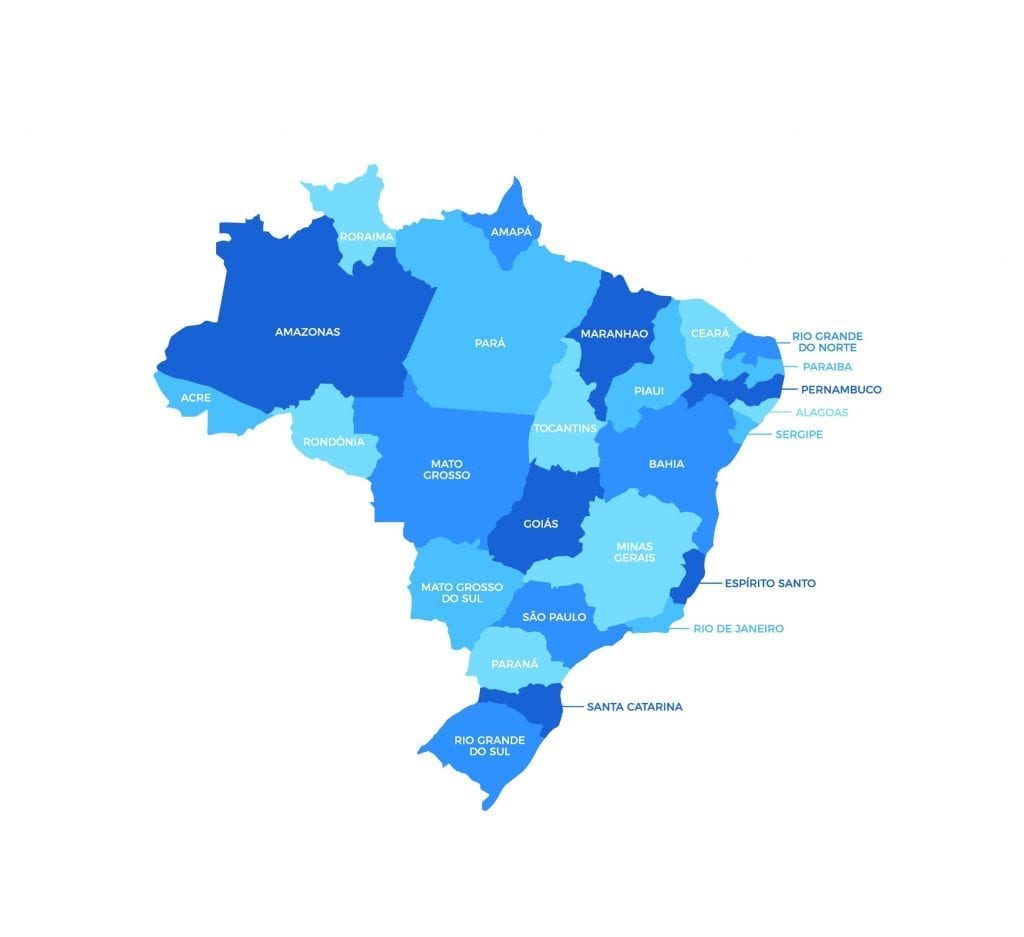
People Map of Brazil vector

Brazil is the largest country in the continent of South America. It is officially called the Federative Republic of Brazil. The Portuguese pronunciation for the same is República Federativa do Brasil. Area wise, Brazil is the fifth largest country in the world, with an area of 8.5 million square kilometers. It also ranks fifth among the most populated countries in the world, with a population of over 208 million people. The capital city of Brazil is Brasilia, and the official language is Portuguese.
Map of Brazil and its borders
Let’s start with an interesting fact. Brazil was named after the Brazilwood trees that grew around the coast of Brazil. Brazil is surrounded by other South American countries on one side and the Atlantic Ocean on the other. It shares borders with all the countries in South America, except for Chile and Ecuador.
To the north of Brazil lies, French Guiana, Suriname, Guyana, Venezuela, and Colombia, while Peru, Bolivia, Paraguay, and Argentina lies to its west. Uruguay shares its Southern borders. The Atlantic Ocean borders the entire Eastern part of Brazil. The coastline of Brazil stretches for 7491 Kms.
Deep dive into Map of Brazil
Brazil is a geographically diverse country because of its size, climate, varied elevations, and natural resources. Brazil also includes several small islands in the Atlantic Ocean, such as Trindade and Martim Vaz, Saint Peter and Paul Rocks, Rocas Atoll, and Fernando de Noronha.
Brazil is the only country in the world that has the Tropic of Capricorn and the Equator running through it. The topographic elevation of the country lies between 200 meters and 800 meters. With scrublands, mountains, hills, plateaus, and coastal areas, Brazil has one of the most diverse terrains. The lowest point in Brazil is the Atlantic Ocean. In contrast, the highest point is Pico da Neblina, which is 2,994 meters above sea-level.
Brazil has a vast network of rivers, all of which flow into the Atlantic. The second largest river in the world, known as the Amazon River, flows through Brazil. Other significant rivers include the Parana and its main tributary, the Iguaçu, the São Francisco, the Xingu, the Tapajós, the Negro, and the Madeira rivers. The Iguaçu river also includes the famous Iguazu Falls.
Climate of Brazil
Brazil mostly has a tropical climate, even though the weather varies across its vast topography. A drier area lies in the Northeast, which is known as drought polygon or drought quadrilateral. It comprises of northern Bahia and extends to the coast between Natal and São Luís.
November to April marks the summer season in the central parts of the Brazilian Highlands. This part of the country receives its highest precipitation during this time, with frequent showers. The climate here varies between storms and floods during one time and drought during the other, making it difficult to sustain in the Highlands.
May to October is the winter season in Brazil. The southernmost cities in Brazil experience snowfall, whereas the rest of the highlands has a dry winter. The winters here are pleasant with cooling winds, though the temperatures in most parts rarely dip below 20ºC.
History of Brazil
Many excavations have revealed that Brazil had a human population existing for almost 8000 years ago. Many indigenous groups were residing in Brazil then. However, the discovery of Brazil is credited to Pedro Alvares Cabral, when the Portuguese landed on the shores of Brazil. On 22nd April 1500, Brazil was claimed for the Portuguese Empire.
The Portuguese started colonising the indigenous groups by dividing them into tribes. The first two centuries after Portuguese colonisation, the indigenous groups, and other European countries were endlessly at war with each other. Each wanted to gain more control over the resources the country had to offer.
Export of sugar became a significant business in Brazil in the mid-16th century. To cope with the mass production of sugar, the Portuguese brought in slaves from their colonies in Africa. By the end of the 17th century, a new resource had gained popularity. Gold export received more importance than sugar. It was known as The Gold Rush, which attracted more people from all over, to settle in Brazil. During this time, the Portuguese fought many wars with other European nations to keep their stronghold maintained in Brazil.
1808 saw the great Peninsular War, wherein the Portuguese fled to Brazil to escape the Napoleon invasion in Portugal. King Joao VI set up the capital in Rio de Janeiro, which lasted for thirteen years. Joao returned to Portugal and left the governing of Brazil to his son Pedro I.
In 1821, Pedro I led Brazil in its war for independence against Portugal. In 1822, Brazil was declared as independent, and Pedro I became its emperor. Brazil was re-established as the Federal Republic after the emperor was overthrown in 1889. Brazil finally got its first civilian president, Fernando Collor de Mello, in 1985, after many mutinies and unstable governments.
Today, Brazil is governed by its 38th President, Jair Bolsonaro. He came into power since 1st January 2019.
Tourism in Brazil
Brazil is the largest South American country, with a rich culture, and diversity in its flora and fauna has attracted many tourists over the years. Adventure tourism and cultural tourism are the most sought after in Brazil thanks to its lovely beaches and the vast stretch of the Amazon forests.
Below are a few of the many star attractions in Brazil.
- Rio de Janeiro: The statue of Christ the Redeemer or as it is known in Brazil, Cristo Redentor, is located at the Tijuca National Park. It is one of the most famous scenes in Rio de Janeiro. Rio is also famous for its carnivals and the grand stretch of the Copacabana beach.
- Iguazu Falls: At the border of Argentina and Brazil, the Iguaçu river falls into a gorge creating spectacular waterfalls. They are the largest waterfalls in the world.
- Fernando de Noronha: This island city has a restricted number of tourists visiting it in a year, maintaining its picturesque landscapes and beaches.
- Amazon: The wilderness of the Amazon Rainforest is one of the stunning ecosystems in Brazil. A distinct species of flora and fauna is found in this thick forest.
- Salvador: The Pelourinho in Salvador is famous for its beautiful churches and monasteries that were built in the 17th and 18th centuries.
- Ouro Preto: Named as a world heritage site by UNESCO, this city in Minas Gerais, means ‘black gold’ when translated. This place has been left untouched since colonisation and speaks of its history of gold trading.
Brazil Flag

Facts about Brazil flag you should know
All flags have a story to describe, and an origin and Brazilian flag is not different from these flags. We investigated into the flag history that describes Brazil. The symbols and colours of all flags convey the values, ambitions and ideas of the country. Some facts about Brazil flag are given below
Appearance
The Brazilian flag is designed in yellow diamond in the centre and bright green colour. The diamond contains a blue globe. The exact quantity of the stars in the flag is 27. The white banner contains a slogan in Brazilian language, and the meaning of this slogan is order and progress.
Looks different
The present Brazilian flag is different from the previous flag during the Brazilian empire. The centre of the flag contains a blue circle that has stars neatly spread inside it, and it is an imperial symbol. Later on, this was replaced with the stars and a blue globe. These stars were closer representing a constellation.
Colours are Symbolic
The colours in the Brazilian flag are the signs of some factors. The flag contains yellow and blue colours with white stars. Yellow is the symbol of the country’s wealth, particularly the country’s gold reserve and Brazilian soil. For flora, fauna and extensive nature, green is the particular option. As we know that Brazil is home to Pantanal and Amazon rain-forest. The flag was different during the Brazilian Empire. It was designed in different colours with different symbolic meaning. The white and blue of previous flag represents the Virgin Mary. The concept of this representation is to show the deep roots of the country in the Catholic religion.
Birthday and Nickname
On November 19, 1889, the flag was designed. It was four days after Brazil had come into being as a republic. The flag was called as the name of the Auriverde. The meaning of this word is golden green. These were the colours of the flags.
Stars are symbol
These are the symbolic parts of the flag. It is the sign of constellations in Southern Hemisphere. It shows how these were seen from Rio de Janeiro. It can be seen on November 15, 1889, in the morning’s early hours. At this day, the country has declared a republic because it was an empire.
Changes in Number of stars
As the flag of the United States of America’s flag, it contained 21 stars. It was the representation of 21 states. Later on, the country was divided into more states. They flag was modified on May 11, 1992, and six more stars were added. Now, the flag contains 27 stars. The slogan on the flag is the symbol to describe successful democracy.
Fun Trivia About Brazil
- Brazil is the only country in South America with Portuguese as its official language.
- Sao Paulo is the largest city in Brazil.
- Approximately sixty percent of the Amazon rainforest lies in Brazil.
- Brazil has around 2500 airports.
- Brazil is one of the 77 founding members of the United Nations.
- There are three time zones in Brazil
- Brazil is the seventh-largest economy in the world
- Brazil carnival is held from Friday to the Tuesday before Ash Wednesday. The entire country celebrates the parade during this time.
- The prevalent Samba music was developed in Brazil in the 1800s.
- Brazil has won the FIFA world cup five times so far in the years 1958, 1962, 1970, 1994, and 2002.
States and Capital Cities of Brazil
- Acre – Rio Branco
- Alagoas – Maceio
- Amapa – Macapa
- Amazonas – Manaus
- Bahia – Salvador
- Ceara – Fortaleza
- Distrito Federal (Federal District) – Brasilia
- Espirito Santo – Vitoria
- Goias – Goiania
- Maranhao – Sao Luis
- Mato Grosso – Cuiaba
- Mato Grosso do Sul – Campo Grande
- Minas Gerais – Belo Horizonte
- Para – Belem
- Paraiba – Joao Pessoa
- Parana – Curitiba
- Pernambuco – Recife
- Piaui – Teresina
- Rio de Janeiro – Rio de Janeiro
- Rio Grande do Norte – Natal
- Rio Grande do Sul – Porto Alegre
- Rondonia – Porta Velho
- Roraima – Boa Vista
- Santa Catarina – Florianopolis
- Sao Paulo – Sao Paulo
- Sergipe- Aracaju
- Tocantins – Palmas
Other Important Cities of Brazil
Altamira, Araguaina, Assis Brasil, Barreiras, Benjamin Constant, Boca do Acre, Cachimbo, Carajas, Caceres, Careiro, Corumba, Cruzeiro do Sul, Foz do Iguacu, Guajara-Mirim, Humaita, Ilheus, Itaituba, Juazeiro, Maraba,Oiapoque, Olinda, Panorama, Parnaiba, Petrolina, Picos, Ponta Pora, Rio Grande, Rondonopolis, Salgueiro, Santa Cruz, Santa Fe do Sul, Santa Maria, Santarem, Santos, Sao Francisco do Sul, Sao Jose do Ribamar, Uberlandia, Vila Velha (Espirito Santo), and Vitoria da Conquista.
Book accommodation in any part of Brazil at great prices
